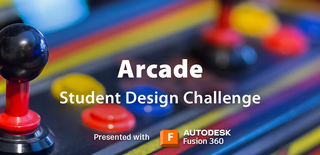Introduction: Modular Arcade Cabinet
At Huron Heights Secondary School in Kitchener Ontario, we created a full-sized Husky Mascot/Donkey Kong-themed Arcade Cabinet with custom wrapped art. The cabinet features a unique modular design that allows us to transport the front panel for use with projectors in addition to regular use with the cabinet-mounted television. The cabinet was designed in Fusion 360, and the art-warp was designed in Adobe Illustrator.
This was a cross-classroom project between a Media Arts, Communication Technology, and Construction class.
Our vision was to design a modular front section to allow us to easily remove the controls and electronics. We devised this plan so that we could both project the game system out to the cafeteria from the lighting booth in addition to regular retro game play in the class using the cabinet-mounted CRT television. So far, we have had schoolwide Super Smash Bros tournaments on the big screen. As well, we are continually designing custom controllers that make use of sensor-based electronics in our Communications Technology course.
This instructable will walk you through our design and build process.
As well, we have shared the Fusion files for the cabinet and detailed photos to allow you to make use of our approach in your own build if you wish.
Supplies
- MDF Boards
- Wood Glue
- Screws
- Woodworking Tools
- Arcade Buttons
- Raspberry PI
- 2X Arcade USB Encoder (For 2 Players)
Step 1: Designing the Cabinet
We designed the cabinet in Fusion 360. Our goal was to adhere to classic/full-sized cabinet dimensions. We then made adjustments for the modular front panel design based on our measurements.
We have attached our Fusion files below if you wish to use them in your own build.
Note that our build was sized for a particular CRT television that we used.
Attachments
Step 2: Cabinet and Front Panel Build
The cabinet was build in a Senior-level Construction Technology class. The arcade made use of a large CRT television that was donated by the Geography department.
As you can see in the attached photos, we designed and built a slot system to easily drop in and/or remove the front panel.
Step 3: Electronics and Controls
Our arcade uses a Raspberry PI 3 running RetroPi.
We purchased buttons and joysticks from RetroActive Arcade following our Purple and White colour scheme. https://retroactivearcade.ca/
We mounted the electronics to the bottom of the control panel. We then housed the PI in a 3D printed enclosure.
Step 4: Cabinet Art Design
Students in a Communication Technology class designed the cabinet art using custom-created vectors in Adobe Illustrator. We scaled our design to follow the template we exported from Fusion.
We selected a Donkey Kong theme that substituted Donkey Kong for our school mascot — Harley the Husky. We used our school colours and experimented with buttons layouts that would work best for the games we planned to load into the system.
A fun easter egg is that the Score we put on the cabinet is the year of our build (002023) and the high score is the classroom number (002505).
Step 5: Cabinet Prep for Art
We had the cabinet professionally wrapped by a local printing company.
We primed the cabinet first and allowed time for off-gassing so that the wrap would adhere correctly and without bubbling. We used two coats of primer to insure full coverage.
Step 6: Final Art Wrap
Here are photos of the final cabinet after the art wrap was applied. We are very pleased with the result.
Step 7: Future Development
As mentioned, beyond regular gameplay, we have also projected the system onto the screen above the stage so students can sign up for tournaments and play while students in the cafeteria watch.
We are making plans for further development with the arcade, including custom controllers that use sensor-based electronics in interesting or non-traditional ways. As well, we plan to build a nicer box to house the control panel when it is removed from the cabinet.
Lastly, we intend to build an extension control panel that can plug in remotely and allow for two additional players to play.
Thanks for reading,
Huron Heights Tech Students

Participated in the
Arcade Student Design Challenge









